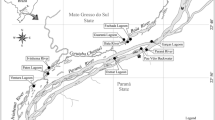Abstract
The Mobile Bay estuary in the northern Gulf of Mexico provides a rich habitat for many fish and shellfish, including those identified as economically and ecologically important. The National Estuary Program in Mobile Bay has focused on restoration of degraded estuarine habitat on which these species depend. To support this effort, we used statistical techniques of ordination, cluster analysis, and discriminant analysis to relate distributions of individual fish and shellfish species and species assemblages to two dozen water quality and habitat variables in a geo-referenced database. Species appeared to respond to dominant gradients of low to high salinity and upland to offshore habitat area; many of the 15 communities identified via cluster analysis showed aggregated spatial distributions that could be related to habitat characteristics. Species in the Mobile River Delta were distinct from those in other areas of the estuary. This analysis supports habitat management in the Mobile Bay estuary; however, due to mobility of organisms among sampling locations and the dynamic environmental conditions in estuaries, we conclude that the analyses presented here are most appropriate for an evaluation of the estuary as a whole.
Similar content being viewed by others
References
Adams, S. M., & Bortone, S. A. (2005). Future directions for estuarine indicator research. In S. A. Bortone (Ed.), Estuarine indicators (pp. 503–506). Boca Raton: CRC.
Akin, S., Buhan, E., Winemiller, K. O., & Yilmaz, H. (2005). Fish assemblage structure of the Koycegiz Lagoon-Estuary, Turkey: spatial and temporal distribution patterns in relation to environmental variation. Estuarine, Coastal, and Shelf Science, 64, 671–684.
Bortone, S. A., Dunson, W. A., & Greenawalt, J. M. (2005). Fish as estuarine indicators. In S.A. Bortone (Ed.), Estuarine indicators (pp. 381–591). Boca Raton: CRC.
Cyterski, M., & Barber, C. (2006). Identification and prediction of fish assemblages in streams of the Mid-Atlantic Highlands, USA. Transactions of the American Fisheries Society, 135, 40–48.
Dantin, D. D., Fisher, W. S, Jordan, S. J., & Winstead, J. T. (2005). Fishery resources and threatened coastal habitats in the Gulf of Mexico. EPA/600/R-05/051. U.S. EPA, Gulf Breeze: US EPA.
Elliott, M., & Quintino, V. (2007). The estuarine quality paradox, environmental homeostasis and the difficulty of detecting anthropogenic stress in naturally stressed areas. Marine Pollution Bulletin, 54, 640–645.
Engle, V. D., & Summers, K. (1998). Determining the causes of benthic conditions. Environmental Monitoring and Assessment, 51, 381–397.
Gray, J. S., Clarke, K. R., Warwick, R. M., & Hobbs, G. (1990). Detection of initial effects of pollution on marine benthos: An example from the Ekofisk and Eldfisk oilfields, North Sea. Marine Ecology Progress Series, 66, 285–299.
Jordan, S. J., & Vaas, P. A. (2000). An index of ecosystem integrity for Northern Chesapeake Bay. Environmental Science & Policy, 3, S59–S88.
Lewis, M., Jordan, S., Chancy, C., Harwell, L., Goodman, L., & Quarles, R. (2007). Summer fish community of the coastal northern Gulf of Mexico: Characterization of a large-scale trawl survey. Transactions of the American Fisheries Society, 136, 829–845.
Livingston, R. J. (1982). Trophic organization of fishes in a coastal seagrass system. Marine Ecology, Progress Series, 7, 1–12.
McCune, B., & Medford, M. J. (1999). PC-Ord software version 4.10: Multivariate analysis of ecological data. Gleneden Beach: MJM Software.
McCune, B., Grace, J. B., & Urban, D. L. (2002). Analysis of ecological communities. Glenden Beach: MJM Software Design.
Meng, L., Orphanides, C. D., & Powell, J. C. (2002). Use of a fish index to assess habitat quality in Narrangansett Bay, Rhode Island. Transactions of the American Fisheries Society, 131, 731–742.
Mullins, M., Burch, H., Dardeau, M., & Sturm, D. (Eds.). (2002). The Mobile Bay National Estuary Program Comprehensive Conservation and Management Plan Volumes 1–3. (Mobile: The Mobile Bay National Estuary Program).
Muncy, R. J. (1984). Species profiles: life histories and environmental requirements of coastal fishes and invertebrates (south Atlantic): White shrimp. U.S. Fish and Wildlife Service FWS/OBS-82/11.27. U.S. Army Corps of Engineers, TR EL-82-4.
Perez-Farfante, I. (1969). Western Atlantic shrimps of the genus Penaeus. U.S. Fish and Wildlife Service Fisheries Bulletin, 67(3), 461–591.
Pittman, S. J., Christensen, J. D., Caldow, C., Menza, C., & Monaco, M. E. (2007). Predictive mapping of fish species richness across shallow-water seascapes in the Caribbean. Ecological Modelling, 204, 9–21.
Schaefer, J., Gido, K., & Smith, M. (2005). A test for community change using a null model approach. Ecological Applications, 15(5), 1761–1771.
Serviess, V. B., Bowen, J. L., Dow, D., & Valiela, I. (2004). Using ecological risk assessment to identify the major anthropogenic stressor in the Waquoit Bay Watershed, Cape Cod, Massachusetts. Environmental Management, 33, 730–740.
Stevens, Jr., D. L., & Olsen, A. R. (2004). Spatially balanced sampling of natural resources. Journal of American Statistical Association, 99, 262–278.
Williams, A. B. (1958). Substrates as a factor in shrimp distribution. Limnology and Oceanography, 3(3), 283–290.
Zharikov, Y., Skilleter, G. A., Loneragan, N. R., Tarranto, T., & Cameron, B. E. (2005). Mapping and characterizing subtropical estuarine landscape using aerial photography and GIS for potential application in wildlife conservation and management. Biological Conservation, 125, 87–100.
Author information
Authors and Affiliations
Corresponding author
Rights and permissions
About this article
Cite this article
Rashleigh, B., Cyterski, M., Smith, L.M. et al. Relation of fish and shellfish distributions to habitat and water quality in the Mobile Bay estuary, USA. Environ Monit Assess 150, 181–192 (2009). https://doi.org/10.1007/s10661-008-0681-z
Received:
Accepted:
Published:
Issue Date:
DOI: https://doi.org/10.1007/s10661-008-0681-z




